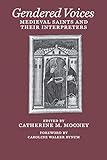Gendered Voices : Medieval Saints and Their Interpreters / Catherine M. Mooney.
Material type: TextSeries: The Middle Ages SeriesPublisher: Philadelphia : University of Pennsylvania Press, [2016]Copyright date: ©1999Description: 1 online resource (296 p.)Content type:
TextSeries: The Middle Ages SeriesPublisher: Philadelphia : University of Pennsylvania Press, [2016]Copyright date: ©1999Description: 1 online resource (296 p.)Content type: - 9780812216875
- 9781512821154
- 270.3/092/2 21
- BX4662 .G46 1999eb
- online - DeGruyter
- Issued also in print.
| Item type | Current library | Call number | URL | Status | Notes | Barcode | |
|---|---|---|---|---|---|---|---|
 eBook
eBook
|
Biblioteca "Angelicum" Pont. Univ. S.Tommaso d'Aquino Nuvola online | online - DeGruyter (Browse shelf(Opens below)) | Online access | Not for loan (Accesso limitato) | Accesso per gli utenti autorizzati / Access for authorized users | (dgr)9781512821154 |
Frontmatter -- Contents -- Foreword -- Abbreviations -- I. Voice, Gender, and the Portrayal of Sanctity -- 2. Hildegard and Her Hagiographers -- 3. Holy Woman or Unworthy Vessel? -- 4. Imitatio Christi or Imitatio Mariae? -- 5. Inside Out -- 6. A Marriage and Its Observer -- 7. Henry Suso and Elsbeth Stagel -- 8. Mystical Death, Bodily Death -- 9. Authorizing A Life -- Notes -- The Saints and Their Interpreters -- Contributors -- Index of Modern Authors -- General Index -- Acknowledgments
restricted access online access with authorization star
http://purl.org/coar/access_right/c_16ec
"These studies . . . not only illuminate the past with a fierce and probing light but also raise, with nuance and power, fundamental issues of interpretation and method."-from the Foreword, by Caroline Walker BynumFemale saints, mystics, and visionaries have been much studied in recent years. Relatively little attention has been paid, however, to the ways in which their experiences and voices were mediated by the men who often composed their vitae, served as their editors and scribes, or otherwise encouraged, protected, and collaborated with the women in their writing projects. What strategies can be employed to discern and distinguish the voices of these high and late medieval women from those of their scribes and confessors? In those rare cases where we have both the women's own writings and writings about them by their male contemporaries, how do the women's self-portrayals diverge from the male portrayals of them? Finally, to what extent are these portrayals of sanctity by the saints and their contemporaries influenced not so much by gender as by genre?Catherine Mooney brings together a distinguished group of contributors who explore these and other issues as they relate to seven holy women and their male interpreters and one male saint who claims to incorporate the words of a female follower in an account of his own life.
Issued also in print.
Mode of access: Internet via World Wide Web.
In English.
Description based on online resource; title from PDF title page (publisher's Web site, viewed 23. Jul 2020)


